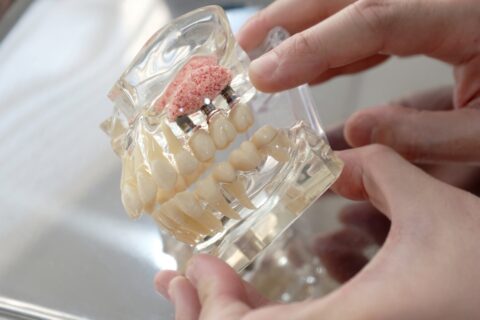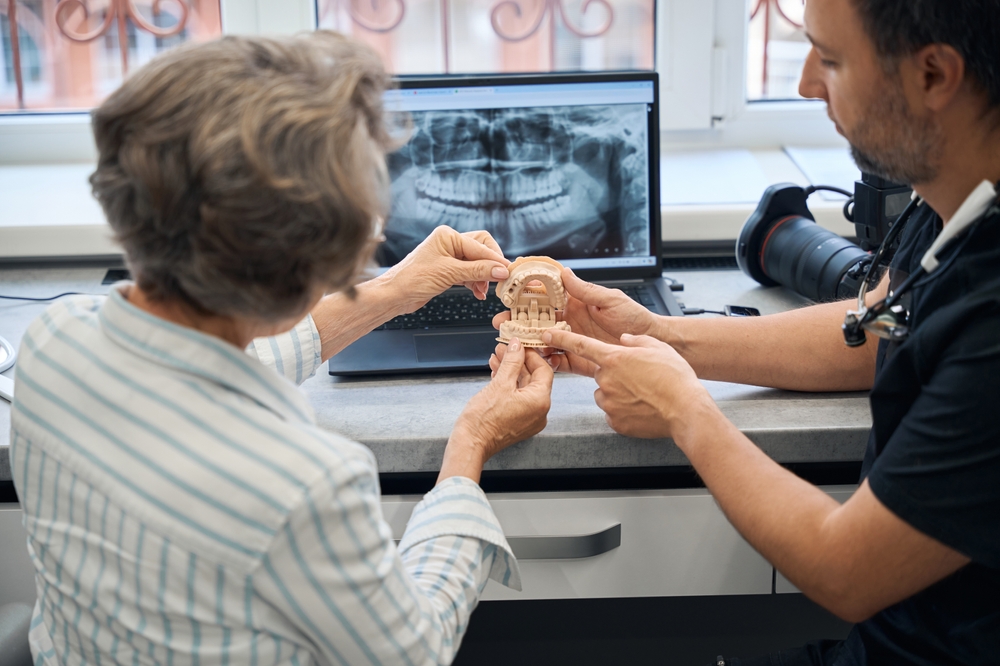
Bone Grafting & Sinus Lifts: When They’re Needed and What You Should Know
Hearing you might need a procedure before getting your dental implant can feel discouraging. If you've been told you don't have enough bone for an implant, you might worry the process is too complicated or that a strong, healthy smile is out of reach. At Infinite Dental Wellness, we want to reassure you. Procedures like bone grafting and sinus lifts are common, safe, and highly effective ways to prepare your jaw for a successful, lifelong dental implant.
These treatments aren't obstacles; they are the very foundation for a beautiful, functional, and permanent tooth replacement. Think of it like building a house—you need solid ground before you can construct a strong home. Bone grafting and sinus lifts create that solid ground in your jaw. Our team in Glendale is here to explain everything in simple terms, answer all your questions, and guide you with gentle, expert care.
Why Bone Grafting and Sinus Lifts Matter for Strong, Lasting Dental Implants
Dental implants are designed to last a lifetime, but their success depends entirely on the strength and density of your jawbone. An implant acts like the root of a natural tooth, anchoring a crown securely in place. For this to work, the implant needs to fuse with solid bone in a process called osseointegration. Bone grafting and sinus lifts are often the key to making this happen.
What happens when bone isn’t strong enough for an implant
When a dental implant is placed in bone that is too thin or soft, it can't create a stable bond. The implant might feel loose, fail to integrate properly, or even shift over time. This can lead to the implant failing completely, requiring removal and starting the process over again. Without a strong foundation, the implant simply won't have the support it needs to withstand the daily pressures of chewing and speaking. We perform bone grafting in our Glendale office to prevent this from ever happening, ensuring your implant has the best possible chance for success from day one.
Why jawbone density matters for long-term implant success
A dense, healthy jawbone provides a secure anchor for the titanium implant post. This stability is what allows you to eat, talk, and smile with total confidence, knowing your new tooth is just as strong as a natural one. Strong bone tissue grips the implant, holding it firmly in place for decades. This is why our dental implant preparation in Glendale always starts with a thorough evaluation of your jawbone density. We don't take shortcuts, because your long-term health and the durability of your smile are our top priorities.
How bone loss can occur after missing teeth or gum disease
Your jawbone is a living tissue that needs stimulation to maintain its shape and density. When a tooth is lost, the bone in that area no longer receives the signals it needs from chewing and biting. As a result, the body begins to resorb the bone, causing it to shrink in both height and width. This process can start almost immediately after tooth loss. Similarly, advanced gum disease (periodontitis) can destroy the bone that supports your teeth, leading to what is known as jawbone loss. Both scenarios can leave you with insufficient bone for a dental implant, making a preparatory procedure necessary.
When a Bone Graft or Sinus Lift Is Needed
Not everyone who gets a dental implant needs a bone graft or sinus lift, but it’s a very common requirement. Determining whether you need extra bone support is a critical part of the planning process. At Infinite Dental Wellness, we use advanced technology and our extensive experience to make a precise and accurate assessment.
Signs you may need extra bone support before an implant
Several factors can indicate that a bone graft might be necessary. You may be a candidate for a bone graft if you:
- Have been missing a tooth for a year or longer, allowing time for bone to shrink.
- Have a history of advanced periodontal (gum) disease.
- Suffered a traumatic injury to your jaw or tooth.
- Naturally have a thin jawbone or large sinus cavities.
- During your consultation, we’ll review your dental history and discuss these factors to understand your unique situation.
How we determine bone quality through digital imaging (CT scans)
To get a clear picture of your jaw, we use state-of-the-art dental technology. A Cone Beam Computed Tomography (CBCT) scan provides a detailed, 3D image of your jawbone, teeth, and surrounding structures. This digital imaging is far more advanced than a standard X-ray. It allows us to measure the exact height, width, and density of your bone with incredible precision. A CT scan for dental implants is the gold standard for evaluation, helping us plan your procedure safely and effectively, and leaving no room for guesswork.
Why the upper jaw often needs sinus lift procedures
The upper jaw, especially in the back where your molars are, presents a unique challenge. This area is right below the maxillary sinuses—the empty, air-filled spaces behind your cheeks. When you lose an upper back tooth, the bone in that area can become very thin, with little separation between your jaw and the sinus cavity. Placing an implant here without addressing the insufficient bone height could cause the implant to puncture the sinus membrane. A sinus lift, or sinus augmentation, is a specialized type of bone graft designed specifically to add bone to the upper jaw, creating the necessary height and support for a successful implant.
Understanding the Bone Graft Procedure
If you need a bone graft, our team will walk you through every step of the process. Our goal is to make the procedure as comfortable, predictable, and stress-free as possible. We prioritize gentle techniques and clear communication, so you always know what to expect.
Types of bone grafts used (synthetic, donor, or your own bone)
There are several types of bone grafting materials we can use, and the choice depends on your specific needs and the extent of the bone loss. The main options include:
- Autograft: Bone taken from another part of your own body, often the chin or back of the jaw. This is often considered the gold standard because it uses your own living cells.
- Allograft: Bone sourced from a human donor. This material is carefully screened and sterilized through a certified tissue bank, making it extremely safe and effective.
- Xenograft: Bone derived from an animal source, typically a cow. This material is processed to be biocompatible and acts as a scaffold for your own bone to grow into.
- Alloplast: A synthetic, man-made material. These biocompatible materials provide a framework that encourages your body to generate new bone.
We will discuss the best type of bone graft for your dental implant procedure during your consultation in our Glendale office.
Step-by-step overview of the bone grafting process
While every case is unique, the bone grafting process generally follows these steps:
- Numbing: We start by thoroughly numbing the area with a local anesthetic to ensure you are completely comfortable. For anxious patients, we can also discuss sedation options.
- Incision: A small incision is made in your gum tissue to expose the underlying bone where the graft is needed.
- Placement: The grafting material is carefully placed in the area with bone deficiency.
- Membrane: Often, a special collagen membrane is placed over the graft to protect it and encourage the growth of new bone tissue while preventing gum tissue from growing into the space.
- Closing: The incision is closed with a few small stitches.
The entire appointment is typically quick and straightforward. We pride ourselves on performing what patients often describe as a painless bone graft.
What to expect during and after the appointment
During the procedure, you will feel no pain, only some light pressure. Afterward, it’s normal to experience some minor swelling, bruising, or soreness, but this is usually manageable with over-the-counter pain relievers and a cold compress. We will provide you with detailed aftercare instructions to ensure a smooth recovery. Our team is always just a phone call away if you have any questions or concerns. We are the "dental grafting near me" that Glendale residents trust for compassionate and attentive care.
How a Sinus Lift Works
A sinus lift is a common and highly successful procedure designed to solve the problem of insufficient bone in the upper back jaw. It’s a delicate technique that our experienced team performs regularly, allowing patients who were once told they couldn’t get implants to restore their smiles permanently.
What is a sinus lift and why it’s sometimes necessary
A sinus lift, also called sinus augmentation, is a surgical procedure that adds bone to your upper jaw in the area of your molars and premolars. It’s performed when the vertical height of the bone is not sufficient to support a dental implant. By adding bone, we create a taller, stronger foundation. The procedure involves gently lifting the sinus membrane and placing a bone graft into the space created. This allows new bone to grow, providing the support your future implant will need.
Gentle techniques we use to raise the sinus membrane safely
The success of a sinus lift depends on carefully handling the delicate sinus membrane. Our Glendale implant team uses minimally invasive surgical techniques to perform this procedure with precision and care. We create a small opening in the bone to access the membrane. Using specialized instruments, we gently elevate the membrane upward, creating a space underneath it. This space is then filled with bone grafting material. Our focus on gentle techniques minimizes discomfort and promotes faster healing.
Combining a sinus lift and implant in the same visit
In some cases, if you have a moderate amount of existing bone, it may be possible to perform the sinus lift and place the dental implant in the same appointment. This is often called a "sinus lift and implant same day" procedure. This approach can shorten the overall treatment timeline, as you won't have to wait for the bone graft to heal completely before getting your implant. We will determine if you are a candidate for this combined procedure after evaluating your bone with our 3D CT scanner.
Recovery and Healing Timeline
Patience is key after a bone graft or sinus lift. Your body needs time to grow new, strong bone around the grafting material. A proper healing period is crucial for the long-term success of your dental implant.
Typical recovery time for bone grafting vs. sinus lifts
The healing timeline can vary from person to person, depending on the size of the graft and your body’s natural healing capacity. Generally, a small bone graft may need about 3 to 4 months to heal. A more extensive graft or a sinus lift might require 6 to 9 months before the bone is dense enough for an implant. We will monitor your progress closely with follow-up appointments and imaging to determine exactly when you are ready for the next stage.
How to care for your mouth after surgery
Proper aftercare is essential for a successful bone graft recovery. We will provide you with a detailed list of instructions, which will include:
- Gently rinsing your mouth with a prescribed or saltwater rinse after 24 hours.
- Avoiding brushing the surgical site directly for the first few days.
- Taking any prescribed antibiotics or pain medication exactly as directed.
- Applying a cold compress to your cheek to reduce swelling.
Following these instructions carefully will help minimize discomfort and prevent complications.
Foods, activities, and habits to avoid while healing
During the initial healing period, it’s important to be gentle with the surgical area.
- Foods: Stick to a soft food diet for the first week or two. Avoid hard, crunchy, or spicy foods that could irritate the site.
- Activities: Avoid strenuous physical activity for the first few days, as it can increase blood pressure and bleeding.
- Habits: Do not smoke or use tobacco products, as they can severely impair healing. Also, try to avoid blowing your nose forcefully or sneezing with your mouth closed after a sinus lift, as this can create pressure that dislodges the graft.
When you can move forward with your dental implant
Once your healing is complete and we confirm with an X-ray or CT scan that your bone is dense and strong, you can proceed with your dental implant surgery. This marks an exciting step in the dental implant stages, as you will be on your way to getting your final, beautiful crown. Patients in Glendale appreciate our clear communication throughout the healing timeline, so they always know where they are in the process.
Risks and How We Minimize Them
Like any surgical procedure, bone grafting and sinus lifts carry some potential risks. However, with modern technology, careful planning, and an experienced team, these risks are very low. At Infinite Dental Wellness, your safety and comfort are our highest priorities.
Common but mild side effects (swelling, soreness, congestion)
The most common side effects are temporary and manageable. These can include swelling of the gums and cheek, minor bruising, some soreness at the surgical site, and slight bleeding. After a sinus lift, it’s also normal to feel some sinus congestion or have a stuffy nose for a short time. These symptoms are part of the natural healing process and typically resolve within a week or two.
How modern technology reduces complications
Our commitment to using the latest technology significantly minimizes bone graft risks and sinus lift complications. Our 3D CBCT scanner allows us to plan the surgery with unmatched precision, avoiding critical structures like nerves and the sinus membrane. Using minimally invasive techniques also leads to smaller incisions, less post-operative discomfort, and faster healing. This makes for a much safer and more predictable procedure for every patient.
Our team’s focus on comfort, safety, and follow-up care
From your first consultation to your final follow-up visit, our team is dedicated to providing a safe and comfortable experience. We take the time to answer your questions and address any anxieties you may have. We offer sedation options for patients who feel nervous about their procedure. Our post-operative care includes detailed instructions and follow-up calls to check on your recovery. This focus on comprehensive, compassionate care is why so many Glendale patients trust us for safe dental implant procedures.
Before & After: Real Results from Our Glendale Patients
While talking about procedures is helpful, seeing the results can be truly inspiring. We have helped countless patients in Glendale and the surrounding communities who thought they could never get dental implants achieve strong, beautiful smiles through bone grafting and sinus lifts.
Restoring smiles with bone grafting and sinus lifts
Many of our patients come to us after being told by other dentists that they weren't candidates for implants due to bone loss. They feel disheartened and worried they will have to live with a gap in their smile or a loose-fitting denture. By using bone grafting or a sinus lift to rebuild their jawbone, we open the door to a permanent, life-changing solution. The before and after transformations are about more than just teeth—they are about restoring confidence, function, and quality of life.
Patient success stories from Infinite Dental Wellness
We are proud of our high rate of Glendale dental implant success. One patient, who had been missing an upper molar for over a decade, had significant bone loss and a low-hanging sinus. He was convinced his only option was a partial denture. After a successful sinus lift procedure, he was able to receive a dental implant. Today, he eats all his favorite foods with ease and smiles without hesitation. These patient testimonials are a testament to what is possible with the right expertise and technology.
What makes our approach different from corporate chains
Unlike large, corporate dental chains that may offer a one-size-fits-all approach, we are a local implant dentist practice that treats you like family. Drs. Kiraj and Muradyan oversee every aspect of your care personally. We don’t rush our patients or pressure them into treatments. Instead, we build a relationship based on trust and create a customized plan that is truly in your best interest. We combine world-class technology with the personalized attention you can only get from a dedicated local practice.
Frequently Asked Questions About Bone Grafting and Sinus Lifts
It’s natural to have a lot of questions. Here are answers to some of the most common ones we hear from our patients in Glendale.
Do bone grafts hurt?
No, the procedure itself is not painful. We use effective local anesthesia to completely numb the area. We also offer sedation dentistry for anxious patients. You can expect some mild soreness during recovery, but this is easily managed with medication.
How long does it take to heal before I get my implant?
The healing time for a bone graft varies, typically between 3 and 9 months. We will monitor your progress and let you know when the new bone is strong enough to support an implant.
Are sinus lifts safe for older adults?
Yes, sinus lifts are very safe for healthy older adults. Age is generally not a barrier to receiving dental implants or preparatory procedures. Your overall health is a more important factor, which we will thoroughly review during your consultation.
What materials are used in bone grafts?
We use a variety of safe, biocompatible materials, including bone from a tissue bank, synthetic materials, or sometimes your own bone. We will select the best material for your specific situation.
Can my implant and graft be done on the same day?
Sometimes, yes. If you have enough existing bone to provide initial stability for the implant, we may be able to perform the graft and place the implant in the same visit. This will be determined during your evaluation.



